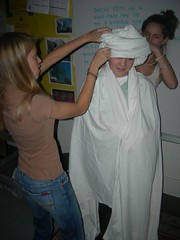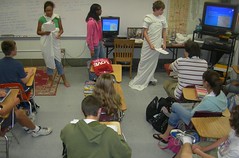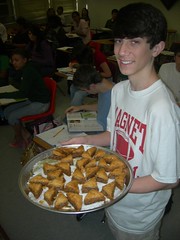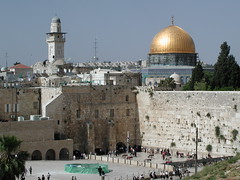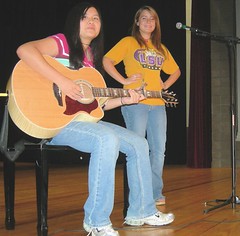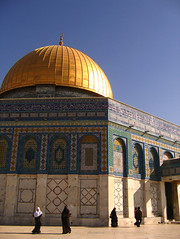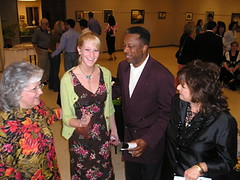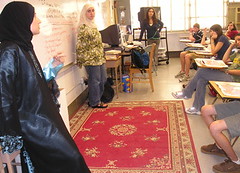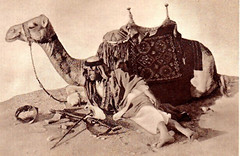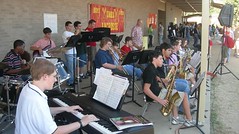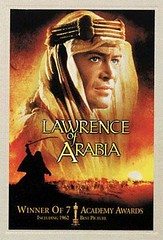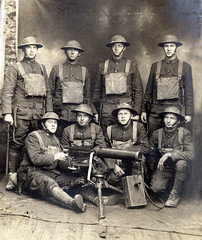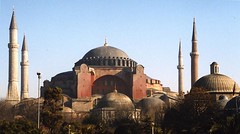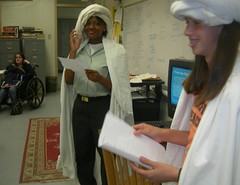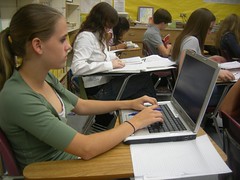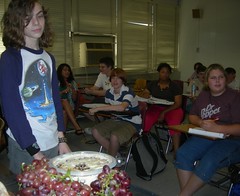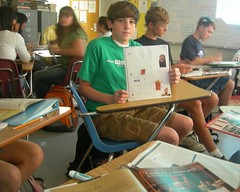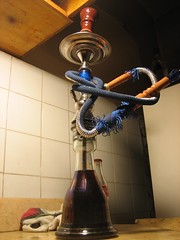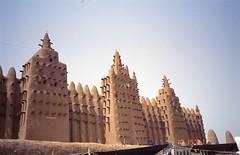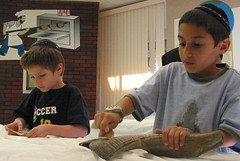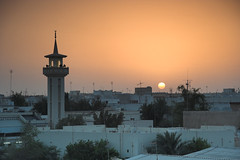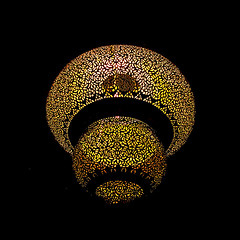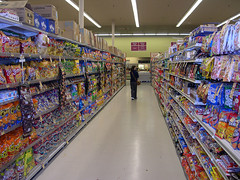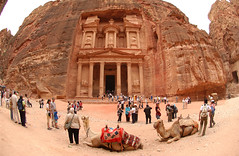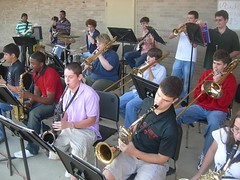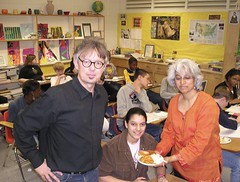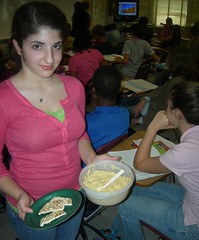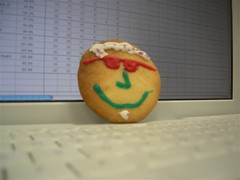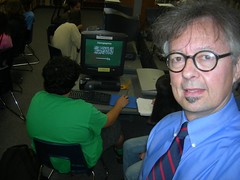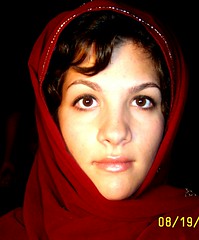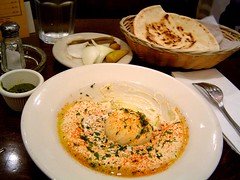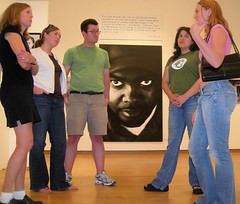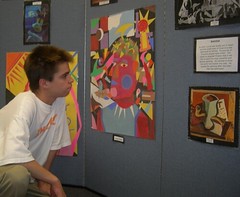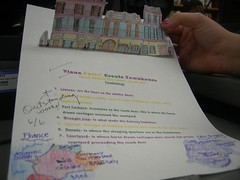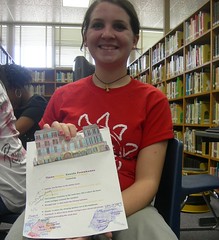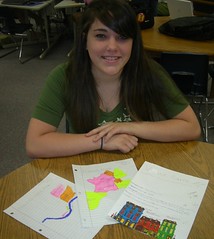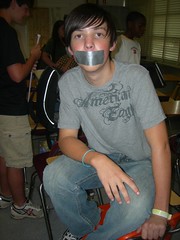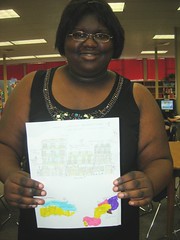Mid East 2 answers
1. F
2. a Bedouins
3. d one third
4. a Mali
5. a Arabic
6. c Sicily
7. a Mecca
8. b Arabesques
9. b Iraq
10. b Austria-Hungary
11. b mnemonic
12. d Bahrain
13. F
14. a Mecca
15. d coral
Saturday, September 30, 2006
Cuisine is sensual & memorable but comparison essays and academic presentations earn more points in geo class
Despite the several food-presentation photos on this blog, I must remind you that comparison essays outnumber offerings of cuisine. Comparison essays ordinarily are worth more points. The reason is that I feel the comparison essay is of higher value in your future.
A reminder of the guidelines:
* snazzy title, explanatory subtitle.
* colorful opening.
* comparison phrases such as "on the other hand," "but far greater," "six times as large," "more limited, however," etc.
* documentation via "according to" at the end of the first paragraph.
* integration of the topics.
* you may add a map or chart.
* must be typed.
A reminder of the guidelines:
* snazzy title, explanatory subtitle.
* colorful opening.
* comparison phrases such as "on the other hand," "but far greater," "six times as large," "more limited, however," etc.
* documentation via "according to" at the end of the first paragraph.
* integration of the topics.
* you may add a map or chart.
* must be typed.
Tyler and his mom researched and produced baklava
Turkish baked pastries of the baklava family are paper-thin pastry sheets that are brushed with butter and folded, layered, or rolled after being filled with ground pistachios, walnuts or heavy cream, and than baked, after which a syrup is poured over them. The various types, such as the sultan, the nightingale's nest, or the twisted turban differ according to the amount and placement of nuts, size and shape of the individual pieces, and the dryness of the final product. So says turkuaz-guide.com.
The history of baklava, like that of many other foods, is not well documented, says wikipedia.org. Though it has been claimed by many peoples, the best evidence is that, despite its Arabic-seeming name, it is of Turkish origin.
It is a splendid moment when my students learn to cook a pan of the classic sweet, baklava. Keep half of it for the family. The class needs only a tiny sample. Even students who've never cooked a thing can follow the directions and produce - solo, believe it or not - a fine pan of the syrup-soaked dessert.
The history of baklava, like that of many other foods, is not well documented, says wikipedia.org. Though it has been claimed by many peoples, the best evidence is that, despite its Arabic-seeming name, it is of Turkish origin.
It is a splendid moment when my students learn to cook a pan of the classic sweet, baklava. Keep half of it for the family. The class needs only a tiny sample. Even students who've never cooked a thing can follow the directions and produce - solo, believe it or not - a fine pan of the syrup-soaked dessert.
Jerusalem, the Old City: a graphic project due Thur, Oct 5
Ancient Jerusalem: a pop-up project due Thur, Oct 5
Jerusalem
Construct a model of the walled city of Jerusalem on one sheet in your notebook.
* Hinge the major buildings and personalities so that they can be popped up for display.
* Bring color to the important items.
* Identify all items with a rectangular label. Print neatly or type the labels.
* Include 4 people:
Abraham,
King David,
Jesus of Nazareth,
Prophet Muhammad.
* Due Th, Oct 5; 25 pts. (late projects will lose 10 pts per day).
* Please also include
- Dome of the Rock
- Western Wall (Wailing wall) of the ancient Jewish temple.
- Church of the Holy Sepulchre.
- Via Dolorosa.
- 3 Gates
- City walls.
- Map of Israel, showing Jerusalem.
- Brief bio (3 items) of one of the personalities. Documentation.
- Titles, spelling, legibilty and neatness are part of the evaluation.
Questions? trudeau@earthlink.net
Jerusalem
Construct a model of the walled city of Jerusalem on one sheet in your notebook.
* Hinge the major buildings and personalities so that they can be popped up for display.
* Bring color to the important items.
* Identify all items with a rectangular label. Print neatly or type the labels.
* Include 4 people:
Abraham,
King David,
Jesus of Nazareth,
Prophet Muhammad.
* Due Th, Oct 5; 25 pts. (late projects will lose 10 pts per day).
* Please also include
- Dome of the Rock
- Western Wall (Wailing wall) of the ancient Jewish temple.
- Church of the Holy Sepulchre.
- Via Dolorosa.
- 3 Gates
- City walls.
- Map of Israel, showing Jerusalem.
- Brief bio (3 items) of one of the personalities. Documentation.
- Titles, spelling, legibilty and neatness are part of the evaluation.
Questions? trudeau@earthlink.net
Abraham: the Middle Eastern patriarch provides a bridge that connects the monotheistic religions
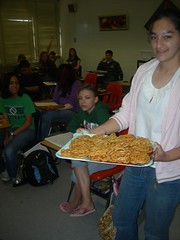
Amal with Palestinian funnel cakes for her class and for iftar at her mosque
Originally uploaded by trudeau.
The accounts of his life found in the Book of Genesis (and for Muslims and Bahai, those in the Qur'an also) are believed to be accurate within the major religions respectively associated with these books, but they have sometimes been assumed to be myths (as opposed to factual) by some secular historians.
Judaism, Christianity, Islam and the Bahá'í Faith are sometimes referred to as the "Abrahamic religions", because of the role Abraham plays in their holy books and beliefs. In the Hebrew Bible and the Qur'an, Abraham is described as a patriarch blessed by God (Genesis 17:5). In the Jewish tradition, he is called Avraham Avinu or “Abraham, our Father”. God also promised Abraham great things, such as that through his offspring, all the nations of the world will come to be blessed (Genesis 12:3).
Jews, Christians, and Muslims consider him father of the people of Israel through his son Isaac (cf. Exodus 6:3, Exodus 32:13). Classical Islamic historians speculated that he was the ancestor of Muhammed through his other son Ishmael. In Christian belief Abraham is a model of faith. In Islam, Abraham obeyed God by offering up Ishmael, and is considered to be one of the most important prophets sent by God.
His original name was Abram; he was the foremost of the Biblical patriarchs. Later in life he went by the name Abraham (Genesis 17:5)
Wikipedia.org
Friday, September 29, 2006
Sunrise atop Mt Sinai on the desolate Sinai Peninsula
The rocky, desert-like Sinai has traditionally been the abode of bandits. Today on the edge of the Sinai there are hotels catering to those who enjoy snorkeling in the Red Sea.
In the southern end is the Mount of Moses - Jebel Musa - and Mt. Sinai. Both are much visited by pilgrims.
TE Lawrence crossed the Sinai during WWI. According to legend, the Holy family of Jesus, Mary & Joseph, crossed the Sinai and made a trek through Egypt.
In 1991 I went to Egypt on a Fulbright Seminar and visited the Sinai. We hiked up the Mt of Moses at night and arrived in time to observe the sunrise over the Biblical land below us.
In the southern end is the Mount of Moses - Jebel Musa - and Mt. Sinai. Both are much visited by pilgrims.
TE Lawrence crossed the Sinai during WWI. According to legend, the Holy family of Jesus, Mary & Joseph, crossed the Sinai and made a trek through Egypt.
In 1991 I went to Egypt on a Fulbright Seminar and visited the Sinai. We hiked up the Mt of Moses at night and arrived in time to observe the sunrise over the Biblical land below us.
Ancient Jerusalem: a pop-up project due Thur, Oct 5
Construct a model of the walled city of Jerusalem on one sheet in your notebook.
* Hinge the major buildings and personalities so that they can be popped up for display.
* Bring color to the important items.
* Identify all items with a rectangular label. Print neatly or type the labels.
* Include 4 people:
Abraham,
King David,
Jesus of Nazareth,
Prophet Muhammad.
* Due Th, Oct 5; 25 pts. (late projects will lose 10 pts per day).
* Please also include
- Dome of the Rock
- Western Wall (Wailing wall) of the ancient Jewish temple.
- Church of the Holy Sepulchre.
- Via Dolorosa.
- 3 Gates
- City walls.
- Map of Israel, showing Jerusalem.
- Brief bio (3 items) of one of the personalities. Documentation.
- Titles, spelling, legibilty and neatness are part of the evaluation.
Questions? trudeau@earthlink.net
* Hinge the major buildings and personalities so that they can be popped up for display.
* Bring color to the important items.
* Identify all items with a rectangular label. Print neatly or type the labels.
* Include 4 people:
Abraham,
King David,
Jesus of Nazareth,
Prophet Muhammad.
* Due Th, Oct 5; 25 pts. (late projects will lose 10 pts per day).
* Please also include
- Dome of the Rock
- Western Wall (Wailing wall) of the ancient Jewish temple.
- Church of the Holy Sepulchre.
- Via Dolorosa.
- 3 Gates
- City walls.
- Map of Israel, showing Jerusalem.
- Brief bio (3 items) of one of the personalities. Documentation.
- Titles, spelling, legibilty and neatness are part of the evaluation.
Questions? trudeau@earthlink.net
Thursday, September 28, 2006
Middle East Test 2: 15 multiple-choice questions on SW Asia; list of the top scoring students
Mid East Test 2:
A perfect score was earned by Andrew Lopez, Brenda Diaz, Katie Li, Molly Bowman & Kelsey Hickman.
Other top scorers on Mid East 2 (93% or higher), of some 140 students, were:
Hannah Connors, Eric Hunt & Brittany Shelley. Lauren Elise Brown, Andrew Delo, Michael Free & Tyler Edwards. Youmna Moufarrej, Payden Deville, Kyle Schuler, Sam Porter, Katy Natale, Chelsea Fields, Hunter Ward, Sara Mustapha, Nicole Lemoine & Susan Beresko. Jayden Sims, Josh Pawlik, Shea Mighell, Katie McCarthy, Scotty Sanders, Andrew Wood & Sydney Merriman. Sarah Arnold, Mason Nabors, Jessie Bradford & Audra Davis.
The test:
Middle East 2 / Trudeau
1. Zakat, or alms and prayers for the poor, expected 5 times a day, is what we would consider the third Pillar of Islam. T / F
2. The aboriginal peoples of the Arabian and North African deserts: a) Bedouins b) Muezzin c) Jihadists d) Emirs.
3. The nations around the Persian Gulf, says National Geographic, supply about __ of the world’s oil. a) a fourth b) half c) three-fourths d) one third.
4. There is a appealing and well-known Great Mosque in Djenne. In what nation is Djenne (also Jenne)? a) Mali b) Tombouctou c) Niger d) Sahara.
5. Words that begin in “al , “ such as alcohol and algebra, are often rooted in the __ language. a) Arabic b) Hebrew c) Urdu
d) Sunni.
6. Was not once part of the Islamic Empire: a) Palestine b) Spain c) Sicily d) Turkey.
7. The Kaaba is located in a) Mecca b) Medina c) Jerusalem
d) Damascus.
8. Vine-like designs or geometric patterns are referred to as
a) Calligraphy b) Arabesques c) Persian art d) Masjid.
9. The Euphrates and Tigris rivers flow through the “land between the rivers,” or Mesopotamia. They flow parallel to each other in what nation? a) Saudi Arabia b) Iraq c) Syria d) Turkey.
10. Allies of the Germans in WWI: a) France b) Austria-Hungary c) Russia d) Italy.
11. A wacky story, a startling phrase, a special design or, sometimes, an acronym: a) repetition b) mnemonic c) comparison d) dossier.
12. The nation with the smallest area on the Persian Gulf:
a) Qatar b) Kuwait c) United Arab Emirates d) Bahrain.
13. The Iranians (Persians) are in the least advantageous strategic position to block the Strait of Hormuz, which lies between the Persian Gulf and the Gulf of Oman. T / F
14. 21N, 40E: Name the city closest to that coordinate:
a) Mecca b) Medina c) Baghdad d) Cairo.
15. If we find that the Red Sea is connected to tourism, we can deduce the presence of a) travelers b) snorkeling rentals
c) colorful fish d) coral.
************
Thanks to Alex Jobe and his mom for sending Gharaib, sugar-butter cookies topped with an almond and typical of a Lebanese wedding. Alex presented a brief background on ingredients and customs, as do all my students. Merci!
*********
Thurs, Oct 5: Jerusalem Pop-up Project 25 pts. See web site notes.
A perfect score was earned by Andrew Lopez, Brenda Diaz, Katie Li, Molly Bowman & Kelsey Hickman.
Other top scorers on Mid East 2 (93% or higher), of some 140 students, were:
Hannah Connors, Eric Hunt & Brittany Shelley. Lauren Elise Brown, Andrew Delo, Michael Free & Tyler Edwards. Youmna Moufarrej, Payden Deville, Kyle Schuler, Sam Porter, Katy Natale, Chelsea Fields, Hunter Ward, Sara Mustapha, Nicole Lemoine & Susan Beresko. Jayden Sims, Josh Pawlik, Shea Mighell, Katie McCarthy, Scotty Sanders, Andrew Wood & Sydney Merriman. Sarah Arnold, Mason Nabors, Jessie Bradford & Audra Davis.
The test:
Middle East 2 / Trudeau
1. Zakat, or alms and prayers for the poor, expected 5 times a day, is what we would consider the third Pillar of Islam. T / F
2. The aboriginal peoples of the Arabian and North African deserts: a) Bedouins b) Muezzin c) Jihadists d) Emirs.
3. The nations around the Persian Gulf, says National Geographic, supply about __ of the world’s oil. a) a fourth b) half c) three-fourths d) one third.
4. There is a appealing and well-known Great Mosque in Djenne. In what nation is Djenne (also Jenne)? a) Mali b) Tombouctou c) Niger d) Sahara.
5. Words that begin in “al , “ such as alcohol and algebra, are often rooted in the __ language. a) Arabic b) Hebrew c) Urdu
d) Sunni.
6. Was not once part of the Islamic Empire: a) Palestine b) Spain c) Sicily d) Turkey.
7. The Kaaba is located in a) Mecca b) Medina c) Jerusalem
d) Damascus.
8. Vine-like designs or geometric patterns are referred to as
a) Calligraphy b) Arabesques c) Persian art d) Masjid.
9. The Euphrates and Tigris rivers flow through the “land between the rivers,” or Mesopotamia. They flow parallel to each other in what nation? a) Saudi Arabia b) Iraq c) Syria d) Turkey.
10. Allies of the Germans in WWI: a) France b) Austria-Hungary c) Russia d) Italy.
11. A wacky story, a startling phrase, a special design or, sometimes, an acronym: a) repetition b) mnemonic c) comparison d) dossier.
12. The nation with the smallest area on the Persian Gulf:
a) Qatar b) Kuwait c) United Arab Emirates d) Bahrain.
13. The Iranians (Persians) are in the least advantageous strategic position to block the Strait of Hormuz, which lies between the Persian Gulf and the Gulf of Oman. T / F
14. 21N, 40E: Name the city closest to that coordinate:
a) Mecca b) Medina c) Baghdad d) Cairo.
15. If we find that the Red Sea is connected to tourism, we can deduce the presence of a) travelers b) snorkeling rentals
c) colorful fish d) coral.
************
Thanks to Alex Jobe and his mom for sending Gharaib, sugar-butter cookies topped with an almond and typical of a Lebanese wedding. Alex presented a brief background on ingredients and customs, as do all my students. Merci!
*********
Thurs, Oct 5: Jerusalem Pop-up Project 25 pts. See web site notes.
Wednesday, September 27, 2006
C4 Gallery displays paintings & collages by artist & teacher Mrs. Marabella Dunn
Drop in to see the work by Marabella Dunn in the display areas and on the wall in C4, please. A good time to visit is Friday between 1:30 and 2:20.
Dunn teaches art at Summerfield Elem and in the Talented Arts Program - which takes place after school at CMHS. This sampling of her work will be on display until November.
In the photo above: Shirlene Alexander, CMHS art teacher, Molly Brau, Class of 2006, Henry Price, Caddo Schools art superviser, and Marabella Dunn.
Dunn teaches art at Summerfield Elem and in the Talented Arts Program - which takes place after school at CMHS. This sampling of her work will be on display until November.
In the photo above: Shirlene Alexander, CMHS art teacher, Molly Brau, Class of 2006, Henry Price, Caddo Schools art superviser, and Marabella Dunn.
Tuesday, September 26, 2006
Sample questions for Thur & independent work topics due any day
Sample questions for Thur:
1. There is a Great Mosque in Djenne, Mali. It is in West Africa, close to both the River Niger and the Sahara. It is built of a) wood & clay b) wood & stone c) wood & textiles d) stone & mud.
2. The Great Mosque in Mecca has a significant courtyard. In it is the a) Hajj b) Shisha c) Ramadan d) Kaaba.
3. "Some Muslims spend the entire night in prayer," during the month of Ramadan, says the Islamic Assoc of North America. T / F
4. The Islamic feast of Rosh Hashanah is known as their New Year, or "head of the year," according to Wikipedia.org. No work may be done on Rosh Hashanah. T / F
5. Vine-like designs or geometric patterns are referred to as
a) Arabesques b) Calligraphy c) Persian art d) Masjid.
6. Shreveport-area Muslims have a new mosque, says the Times. It is in Bossier City and was once of a different denomination. It was a
a) Presbyterian Church b) Baptist Church c) Catholic Church
d) Jewish Temble.
7. The Rub al Khali ("empty quarter") is a vast desert in a) Saudi Arabia b) Iraq c) Oman d) UAE.
8. In the nation of __ is the region known as Mesopotamia, "land between the rivers." The nation of the Euphrates and Tigris rivers is a) Iraq b) Iran c) Syria d) Turkey.
**********
Independent research -
* Compare the Triumph or Brough cycle companies with the Harley-Davidson company.
* Compare the traditions of the Muslim prayer beads and the Catholic rosary.
* What are the reasons for the sporadic but heavy rainstorms which occur in the Arabian desert?
From toursaudiarabia.com:
The average annual rainfall for Saudi Arabia is 4.4 inches (112 mm) per year but whole regions may not experience rainfall for several years. The rainfall usually consists of one or two high intensity, short duration thunderstorms. Even a small storm with little precipitation can produce dangerous flooding because the Saudi Arabian desert soil does not soak up water very easily. Dry wadis (ravines) can quickly turn into raging rivers during and after heavy rains. In the city, low points in the roadway can quickly fill with floodwaters trapping unsuspecting motorists.
Also:
Saudi Arabian Trivia
With limited natural water resources, the country had no choice but to resort to well water and to the sea to provide its increasing population with the water they need. Saudi Arabia has 30 desalination plants located on the West and East coasts of the country and ground water is available from 18 aquifers with deep wells supplying water for municipal use, agriculture and industry.
1. There is a Great Mosque in Djenne, Mali. It is in West Africa, close to both the River Niger and the Sahara. It is built of a) wood & clay b) wood & stone c) wood & textiles d) stone & mud.
2. The Great Mosque in Mecca has a significant courtyard. In it is the a) Hajj b) Shisha c) Ramadan d) Kaaba.
3. "Some Muslims spend the entire night in prayer," during the month of Ramadan, says the Islamic Assoc of North America. T / F
4. The Islamic feast of Rosh Hashanah is known as their New Year, or "head of the year," according to Wikipedia.org. No work may be done on Rosh Hashanah. T / F
5. Vine-like designs or geometric patterns are referred to as
a) Arabesques b) Calligraphy c) Persian art d) Masjid.
6. Shreveport-area Muslims have a new mosque, says the Times. It is in Bossier City and was once of a different denomination. It was a
a) Presbyterian Church b) Baptist Church c) Catholic Church
d) Jewish Temble.
7. The Rub al Khali ("empty quarter") is a vast desert in a) Saudi Arabia b) Iraq c) Oman d) UAE.
8. In the nation of __ is the region known as Mesopotamia, "land between the rivers." The nation of the Euphrates and Tigris rivers is a) Iraq b) Iran c) Syria d) Turkey.
**********
Independent research -
* Compare the Triumph or Brough cycle companies with the Harley-Davidson company.
* Compare the traditions of the Muslim prayer beads and the Catholic rosary.
* What are the reasons for the sporadic but heavy rainstorms which occur in the Arabian desert?
From toursaudiarabia.com:
The average annual rainfall for Saudi Arabia is 4.4 inches (112 mm) per year but whole regions may not experience rainfall for several years. The rainfall usually consists of one or two high intensity, short duration thunderstorms. Even a small storm with little precipitation can produce dangerous flooding because the Saudi Arabian desert soil does not soak up water very easily. Dry wadis (ravines) can quickly turn into raging rivers during and after heavy rains. In the city, low points in the roadway can quickly fill with floodwaters trapping unsuspecting motorists.
Also:
Saudi Arabian Trivia
With limited natural water resources, the country had no choice but to resort to well water and to the sea to provide its increasing population with the water they need. Saudi Arabia has 30 desalination plants located on the West and East coasts of the country and ground water is available from 18 aquifers with deep wells supplying water for municipal use, agriculture and industry.
Study guide to the movie Lawrence of Arabia
Trudeau’s Study Guide to Lawrence of Arabia
A Basis for Testing, Discussion and Essays on the biographical movie.
Please answer questions and use as a framework for notes in each viewing.
This true story is based on books TE Lawrence wrote after the Arab campaigns. He won acclaim for his chronicle of war and politics, the Seven Pillars of Wisdom.
1) Movie director David Lean insists that the musical themes be heard by the audience over a black screen. Why?
2) The movie opens in England, 1935. Enjoy the brief but loving camera attention to a fine British motorcycle. Lawrence wrecks and is
__ injured.
3) Lawrence is buried in St. Paul’s Cathedral, London, a burial place reserved for national heroes. Remarks heard in the crowd: L. was a complex fellow. He was not a perfect hero. He was an enigma.
4) Cairo, Cartography department, British Army, about 1914. In several ways L. stands out from the soldiers with which he is serving. Explain. What is cartography?
5) What are the dates of WWI? Name the nations aligned with the British. Name the countries working with the Germans.
6) Vocab: overweening, dossier, Oxfordshire.
7) What language has L. studied in addition to his mother tongue and French?
8) In Arabia there is a conflict between the tribal Bedouin peoples and the Turks, rulers of the Turkish Ottoman Empire - which includes Arabia. Who’s on the German side?
9) Is “the Officer’s Mess” a term for a carelessly kept room or the principal lounge area?
10) Arabian tribes are led by the wise, if weary, Prince Feisal of Mecca (see Faisal today).
11) What is the attitude of L’s desert guide toward the British officer’s pistol carried by L.? How does L. use the pistol in making his way amongst the Bedouins?
12) The Arabic word for canyon, usually a dry, rocky area between mesas, is “wadi.” The wadi is where Arabs have typically made their settlements.
13) The Harish versus the Hazimi: is murderous tribal warfare a historic part of life in the vast desert? Are there such conflicts today?
14) What kind of vessel is used to bring up water from the deep well in the desert?
15) Translate “God be with you” into Arabic.
16) L. sings a WWI era ditty called “The Man who Broke the Bank at Monte Carlo.” Where is Monte Carlo? In gambling, what does it mean to “break the bank”?
17) A Britishism for being posted to a unit is “seconded.”
18) What is meant by the term biplane?
19) Where did the Turks get airplanes? Not “at the store.”
20) What sound can Arabs seem not to be able to pronounce?
21) In the caravan some camels are surmounted by small, square tent enclosures. Who is in such a tent?
22) “Recite, then, as much of the __ as may be easy for you ... and seek ye the forgiveness of God. Verily, God is forgiving, merciful ...” These are the opening words of the Holy Qu’ran. The scene in Feisel’s tent is unusually respectful of Muslims. Why do I say “unusually”?
23) Lawrence quotes the Quran. How would he know such material?
24) In 1915 the top British priority in the Mid East was protection of a waterway important to their shipping and movement of warships. The name of this key passage?
25) In explaining to Feisel the reason for Britain’s power the British officer puts an emphasis on ... a) technology b) discipline c) skill d) wealth.
26) In the early 1900’s the city at the center of Islamic art, business and scholarship was not Mecca, nor Cairo. It was the capital of Syria: __ .
27) According to Feisel, do Arabs love the desert? If not, what do they love?
28) Feisel refers to the Islamic golden age. About what century did it occur? According to brainyencyclopedia.com, it lasted from about 750 to 1050 AD.
29) At the desert’s edge Lawrence spends a night concentrating on the Arab dilemma in their feckless fight against the Turks. He has a breakthrough. What is his solution?
30) A terrible desert’s difficulties must be surmounted by the Bedouin.
The desert is the a. Sahara b. Rub al kali c. Arezy an Nefud.
31) “The Howeitat are brigands.” Write a synonym for brigand.
32) What 3 nations has Lawrence visited thus far?
33) Can a man claiming to perform a miracle be judged guilty of blasphemy? Why or why not? By definition, miracles are created by __.
34) The boys who become Lawrence’s servants are unsuitable, he is told, because they are “outcast, parentless.” What would we call them?
35) What is a shilling?
36) “Allah favors the compassionate.” Offer a synonym for compassionate.
37) During the desert crossing why does Lawrence use precious water for shaving?
38) Which character has 2 African bodyguards? Is that a realistic note or an exaggeration?
39) In sh’Allah is a frequent interjection and means: a. If God is willing. b. God be with you. c. I believe in God. d. God is merciful.
40) Gasim the Bedouin falls off his camel and is lost in the desert during the night.
Why does Lawrence stubbornly insist on going back to try to find him?
41) In the desert the Bedouins find a place surrounded by trees where their camels can drink. It is called an __ . What kind of trees are those? __ __ .
42) An argument about the role of fate is waged between Lawrence and the Arabs.
The Englishman’s key phrase is “Nothing is __.”
43) Lawrence’s father, he explains, is Sir Thomas Chapman. What is the problem?
44) Lawrence is awarded the robes of a tribesman for his valorous service. Describe him as he faces the wearing of foreign clothing.
45) After some tricky negotiations Auda Abu Talib of the Howeitat says “Dine with me in __ Ruum!”
46) The camel driver’s stick is often used for another purpose. Describe.
47) Auda Abu Talib says “’The Arabs,’ What tribe is that?” What does he imply?
48) What is a guinea?
49) What city will be attacked by the combined tribes in a surprise raid? It lies on what body of water?
50) When the troops leave the wadi the women watching them emit a high-pitched scream as encouragement. What is that called?
a. ovulation b. ululation c. trepidation d. insubordination.
51) “The law says the man must die.” This is based on a code associated with a historic leader of Mesopotamia. a. Cyrus b. Hammurabi c) Darius.
52) In the tribal dispute - which almost begins a blood feud - who is the condemned murderer? Who is the executioner? What irony is there?
53) The Turks at Aqaba outnumber and outgun the Arabs but the Bedouin raiders are successful. What is their great advantage?
54) Lawrence declares he will cross the badlands of the Sinai Peninsula. Where is he going?
55) The servant boy Daud dies in the desert in a most unexpected way. What is it?
56) When a camel lies down, which set of legs folds first?
57) The spooky, abandoned buildings encountered on the edge of the Sinai actually lie beside the body of water called the __ __ .
58) “Bringing a ‘wog’ into the Officer’s Mess” is offensive to many soldiers. Explain.
59) “Undisciplined, unpunctual, untidy; knowledge of languages, music, literature, etc.” Who is being described?
60) In WWI the British attacked the Turkish-held Mid East and drove the Turks from the holy city of __.
61) “You acted without orders.”
“Shouldn’t an officer use their initiative at all times?”
Explain.
62) Lawrence leads Bedouin riders in swift attacks on the Turks that depend on surprise for success. Today that’s called __ warfare (French word).
63) The Bedouins are wary of being partners with the British. They believe that the British are thinking, “Let the Arabs drive out the Turks, then we’ll take over.”
T / F
64) Intermission is another opportunity for the director to air his score over a dark screen. What does this imply?
65) The American reporter called Bentley in the movie is another true element in the Lawrence story. What happens as a result of Bentley’s stories and photos?
66) Lawrence uses his expertise in explosives against the Turkish __.
67) What is the Geneva Code?
68) What happens to the Bedouin army after the looting of Turkish trains?
69) Why does Lawrence shoot and kill his servant and friend Farraj?
70) Lawrence allows himself to be captured by the Turks in Deraa. Why?
71) Is there such a thing as a fair-haired, blue-eyed person of Middle Eastern blood? Is a Circassian the same as a Caucasian?
72) Write a brief description of the location of the Caucasian Mountains.
73) On the eve of the battle for Jerusalem, Lawrence has a breakdown. What action does he take?
74) The Sykes-Picot Treaty is an agreement at the end of WWI that proclaims that 2 nations will divide the control of the Middle East. Which European nations took over the defeated Turkish Empire?
75) Is Lawrence guilty of having told the Bedouins “half lies” about their future and control of their ancient lands? Was he guilty of naiveté?
76) What happened to Lawrence while being held by the Turks in Deraa?
77) On the eve of the attack on the Turks in Damascus, people notice that Lawrence is a changed man. Describe his attitude.
78) Lawrence’s personal troops are hired soldiers. The word for commercial soldiers is __.
79) General Allenby is chauffeured in what brand of British auto?
80) Who wins the race to conquer the Turks in Damascus, the Arabs or the British?
81) The tribal people form a government in Damascus. It is called the __ __.
82) The Arab armies prove incapable of governing Damascus. What governance factors flummox the Arabs?
83) The Arab tribal leaders leave Damascus and return to their homes in __.
84) What factor is repulsive to Lawrence in his return to Britain?
85) Lawrence did not want to be famous as a successful soldier. His desire was to be recognized as a significant writer. Did he reach his goal?
** ** **
Monday, September 25, 2006
Caddo stats from the School Board: 2006-07 MiniFacts Brochure
Selected material from Caddo Schools' MiniFacts:
Enrollment:
CMHS 1,178
Capt Shreve 1,232
Byrd 2,052
Fair Park 729
Green Oaks 510
Huntington 1,327
N Caddo 408
Northwood 993
Southwood 1,589
Booker T Washington 456
Woodlawn 838
Caddo Schools est 1877.
Total enrollment today is 45,152.
System includes 74 schools: 41 elem, 5 elem/middle, 10 middle, 11 high schools & 7 special.
Certified personnel: 3,288; classified: 3,018; subs: 3,524.
Enrollment:
CMHS 1,178
Capt Shreve 1,232
Byrd 2,052
Fair Park 729
Green Oaks 510
Huntington 1,327
N Caddo 408
Northwood 993
Southwood 1,589
Booker T Washington 456
Woodlawn 838
Caddo Schools est 1877.
Total enrollment today is 45,152.
System includes 74 schools: 41 elem, 5 elem/middle, 10 middle, 11 high schools & 7 special.
Certified personnel: 3,288; classified: 3,018; subs: 3,524.
Intro to the life of TE Lawrence, the British bastard and WWI hero
TE Lawrence, 1888-1935
* British
* bastard
* scholar: castles, Crusades, Mid East / Arabic
* fitness
* Brough motorcycle
* Lawrence of Arabia based on the true story of his life.
* Lawrence’s death.
* Hero’s funeral in London, 1935.
* No one quite knew him well. Remained an enigma.
* cartographer
* Cairo, British Army
* Officer’s Lounge called The Mess.
* insubordinate
* “bloody” once a strong English expletive.
* Arabs (allied w English) vs. Turks (allied w Germans)
* Lawrence to Arabia to advise Arab army & King Faisal.
************
Fri, Sept 30: All-school Talent Show, 6:30
Fri, Dec 1: Class 2010 Talent Show
************
Answers to MidEast1 Open Notes Test
1. d Qatar 2. d Istanbul 3. c Tehran 4. a North
5. a Al qaeda 6. b Beirut 7. d Giza 8. d muezzin
9. False 10. d Lower Manhattan 11. c fiddle
12. b Brisbane 13. b Pacific 14. d Ozzies 15. a coral
16. c aborigines 17. c Uluru 18. b Cairo 19. True
20. d Yemen 21. d South 22. a Judaism 23. c Islam
24. c Islam 25. a Judaism 26. a Judaism
27. a Judaism 28. d monotheism 29. d minaret
30. d Saudi Arabia, Iran, Kuwait.
Test guidelines include -
* Name, date, hour in upper-right corner of answer sheet.
* Title.
* No communication (notes, whispering, etc) of any sort, no matter what the reason.
* Check with the teacher on any and all questions.
* Keep your eyes on your desk and especially do not glance at other’s papers.
* Use notes, textbook, atlas, reference books in classroom.
* No use of computers.
* Legibility and spelling are priorities.
Poison gas and trenches: overview of WWI
WWI, 1914 - 1918 (US in the war 1917 - 1918)
Map . . .
Allied Powers -
* England
* France
* Italy
* Russia
Central Powers -
* Germany
* Prussia
* Austria-Hungary
* Ottoman Empire (most of the Middle East, including Palestine and Egypt)
New weaponry
* poison gas
* machine gun
* armored tank
* biplane
* zeppelin
old weapons -
* trenches: soldiers stayed in trenches for months, a painful & disease-ridden experience.
* war of attrition: whoever has the most men alive after deliberately bloody warfare.
outcomes -
* enormous loss of life & brain power.
* Europe no longer the world’s center of power.
* WWI creates conditions for coming of WWII.
* Arab betrayal by European powers at war’s end.
Camels to ultra-modern hotels: the Arabian peninsula / map quiz Tues, Sept 26
Week of Sept 25
Tues: hand sketched map of Arabia and neighbors
Sketch borders & place 12 items in correct locations. Symbols are in parentheses as study aid.
1.Saudi Arabia (desert sands)
2. Mecca (Great Mosque of Mecca)
3. Medina (the Prophet’s Mosque)
4. Yemen (oasis / date palm)
5. Oman (Bedouin on camel)
6. United Arab Emirates (Emir, or prince; also, modern hotel)
7. Qatar (oil-rich sheik)
8. Kuwait (oil well derrick)
9. Iraq (army general resembles Saddam Hussein)
10. Jordan (Queen Rainia, well-spoken, fashionable woman seen on recent Ch One interview)
11. Red Sea (scuba & snorkeling in the clear water)
12. Arabian Sea (historic ship, a dhow, symbolic of trading between India, Arabia & Africa)
13. Persian Gulf (super tanker helping transport one third of the world’s oil supply out from the gulf) .
Sunday, September 24, 2006
Week of Sept 25: Europe & Arabia / TE Lawrence, WWI and Arab independence
Lawrence of Arabia is an award-winning, classic and true story of the early 1900's and the conflict between Arabs and Europeans (and, by extension, America). The story centers on the adventures of an unusual British scholar-soldier, T.E. Lawrence.
In class:
* complete MidEast nations powerpoints
* Tues map quiz on the Arabian peninsula. Deadline for 5 Pillars of Islam project.
* Thurs open notes quiz on SW Asia and Lawrence.
* viewing the movie, which is rather long, and using my guide to the characters and plot.
First installment of the Lawrence bio - from worldwarone.com:
Thomas E. Lawrence: British archaeological scholar, adventurer, military strategist, and the writer of The Seven Pillars of Wisdom (1927), an ambitious work, which combines a detailed account of the Arab revolt against the Turks and the author's own spiritual autobiography. T.E. Lawrence's (1888-1935) enigmatic personality still fascinates biographers and his legend has survived many attempts to discredit his achievements.
T.E. Lawrence was better known in his lifetime as 'Lawrence of Arabia' because of the dashing role he played in helping the Arabs against the Turks during World War I. At 31 Lawrence was an international celebrity but, embittered by his country's Middle East policies, he chose a life of obscurity and died at the age of 46 after a motorcycle accident.
Lawrence was born in Tremadoc, Caernarvonshire, Wales, the illegitimate son of Thomas Chapman. His father left his wife, who had refused to allow a divorce. He set up a new home with Sarah Junner, a woman who had been governess in his household. Lawrence was the third son of this union.
By the age of four Lawrence started to read books and newspapers. He was educated at Oxford High School and subsequently won a Welsh scholarship to Jesus College, Oxford. In the summer of 1909 he began a walking tour in Syria, Palestine, and parts of Turkey.
By September he had covered some 1,100 miles. Lawrence visited 36 crusader castles, made careful notes and then wrote a thesis on 'The Influence of the Crusades on European Military Architecture - to the End of the XIIth Century". In 1910 Lawrence obtained a first class degree in history and was awarded a research fellowship for travel by Magdalen College.
In class:
* complete MidEast nations powerpoints
* Tues map quiz on the Arabian peninsula. Deadline for 5 Pillars of Islam project.
* Thurs open notes quiz on SW Asia and Lawrence.
* viewing the movie, which is rather long, and using my guide to the characters and plot.
First installment of the Lawrence bio - from worldwarone.com:
Thomas E. Lawrence: British archaeological scholar, adventurer, military strategist, and the writer of The Seven Pillars of Wisdom (1927), an ambitious work, which combines a detailed account of the Arab revolt against the Turks and the author's own spiritual autobiography. T.E. Lawrence's (1888-1935) enigmatic personality still fascinates biographers and his legend has survived many attempts to discredit his achievements.
T.E. Lawrence was better known in his lifetime as 'Lawrence of Arabia' because of the dashing role he played in helping the Arabs against the Turks during World War I. At 31 Lawrence was an international celebrity but, embittered by his country's Middle East policies, he chose a life of obscurity and died at the age of 46 after a motorcycle accident.
Lawrence was born in Tremadoc, Caernarvonshire, Wales, the illegitimate son of Thomas Chapman. His father left his wife, who had refused to allow a divorce. He set up a new home with Sarah Junner, a woman who had been governess in his household. Lawrence was the third son of this union.
By the age of four Lawrence started to read books and newspapers. He was educated at Oxford High School and subsequently won a Welsh scholarship to Jesus College, Oxford. In the summer of 1909 he began a walking tour in Syria, Palestine, and parts of Turkey.
By September he had covered some 1,100 miles. Lawrence visited 36 crusader castles, made careful notes and then wrote a thesis on 'The Influence of the Crusades on European Military Architecture - to the End of the XIIth Century". In 1910 Lawrence obtained a first class degree in history and was awarded a research fellowship for travel by Magdalen College.
Saturday, September 23, 2006
Shreveport-Bossier Islamic community creates new mosque in former First Presbyterian Church, Bossier
Times religion reporter Diane Haag wrote about Shreveport-Bossier Muslims on Sept 23: "Ramadan, the holiest month of the Muslim year begins today. This year the Muslim community plans a bigger celebration especially now that they have a new building.
"It's like a charge" for a battery, Imam Syed Juma Salam said. "We're charging our hearts this month with prayer, fasting, Quran and love."
During the month of spiritual and physical purification, believers fast from food, drink, sex and smoking during daylight hours. They ask God for mercy, forgiveness and salvation.
This year they plan daily feasts to break the fast, guest speakers and more people involved in reciting the Quran.
About 10 months ago, the congregation purchased the former First Presbyterian Church on Delhi in Bossier City. Outside it still has the appearance of a traditional Christian church.
Inside, pews have been removed from the sanctuary and when people come to pray they face away from the stage and toward a carved niche in the northeast corner (toward Mecca). Temporary partitions in the back cordon off a section for women.
They are doing some particular work on the bathrooms so they have more room for the ritual cleansing before prayer.
"We had outlived the old mosque," said Khushid Khan, vice president of the board. "It was too small. Over here we can have everyone and have space."
**********
In the illustration above is another church site conversion. Called the Hagia Sophia, Church of Holy Wisdom, it lies in Istanbul. After an Islamic takeover of the region - Constantinople became Istanbul - it was converted to a mosque. That was in 1435, according to Wikipedia.org.
Two useful sites from infoplease.com: one on capitals and one on nations' predominant religions
Infoplease.com has a number of sites that are perfect for our needs. Among them are this site on capitals: http://www.infoplease.com/ipa/A0855603.html?mail-09-07
And this site on world religions: http://www.infoplease.com/ipa/A0855613.html?mail-09-07
Thanks to Garrett Brown's mother, Robin Letulle, for pointing out the sites to me.
And this site on world religions: http://www.infoplease.com/ipa/A0855613.html?mail-09-07
Thanks to Garrett Brown's mother, Robin Letulle, for pointing out the sites to me.
What to put on the Christmas or birthday gift list: laptop or notebook computer
Students bringing a computer to class will use it to
a) take notes.
b) read the class web site.
c) check reference sources for the teacher and class in regards questions that come up during class.
d) work on independent social studies projects when required work has been completed early.
* And I will monitor the screen to make sure the student remains on task.
* This extra tool might be an effective idea for students who have trouble staying engaged and on task in class.
a) take notes.
b) read the class web site.
c) check reference sources for the teacher and class in regards questions that come up during class.
d) work on independent social studies projects when required work has been completed early.
* And I will monitor the screen to make sure the student remains on task.
* This extra tool might be an effective idea for students who have trouble staying engaged and on task in class.
Jonathan's tzatziki, pita and grapes
Tzatziki sauce is made with cucumbers, yogurt and spices and is a delicious, cool white sauce. It's tart & sweet.
Jonathan Weber and his mom, Anita, presented the dish to his class with pita bread and grapes.
You can enjot tzatziki sauce with pita at Yeero Yeero and I highly recommend it.
Also presenting a Middle Eastern treat Friday was Kaylah Williams. Dates and a comparison essay on the fruit of the date palm and yogurt were well presented by Kaylah to an appreciative 2nd hr class.
Jonathan Weber and his mom, Anita, presented the dish to his class with pita bread and grapes.
You can enjot tzatziki sauce with pita at Yeero Yeero and I highly recommend it.
Also presenting a Middle Eastern treat Friday was Kaylah Williams. Dates and a comparison essay on the fruit of the date palm and yogurt were well presented by Kaylah to an appreciative 2nd hr class.
Illustrate the 5 Pillars of Islam
Use clippings, sketches or a combination thereof to bring to life the 5 Pillars of Islam. It should all fit on one page of your notebook. The experiment is to see whether adding illustrations makes it easier to remember these ancient commandments.
Due Tuesday. 5 pts.
There may also be a quick quiz to see whether you've committed the Pillars to memory.
Due Tuesday. 5 pts.
There may also be a quick quiz to see whether you've committed the Pillars to memory.
Friday, September 22, 2006
Shisha: relaxation pipe of Middle eastern peoples
No, the people of the Middle East do not smoke illegal substances in the water pipe. The Koran forbids alcoholic drinks and also any form of intoxication, I've been told (am doing more research on this item). But for relaxation, it is an ancient remedy. Flavored tobacco (cherry, apple, etc) is the usual fare.
Somehow the smoke travels from the pipe bowl at the top of the tall stem to the water bowl and thence to the leather tube which leads to the consumer's mouth. It produces, they believe, a cooler smoke.
Today young women smoke them in public - in cafes and restaurants. In US college towns a shisha bar may be a fashionable new boite.
Somehow the smoke travels from the pipe bowl at the top of the tall stem to the water bowl and thence to the leather tube which leads to the consumer's mouth. It produces, they believe, a cooler smoke.
Today young women smoke them in public - in cafes and restaurants. In US college towns a shisha bar may be a fashionable new boite.
A million Muslims visit Mecca during the Hajj
The Great Mosque of the city of Mecca, birthplace of the Prophet Muhammad, is the focal point of Muslim prayer and the place of the Hajj, which is observed annually.
In the center of the open courtyard is the Kaaba, a shrine in whose corner is a silver frame surrounding the Black Stone. The stone is seen by Arabs and Muslims as a communication from God (Al lah) in heaven.
Compare the meaning of the Sacred Mosque with that of the Christian cathedrals such as St Peter's Basilica, Rome, and Notre dame de Paris. You may compare the Black Stone to the Shroud of Turin, revered by Chrsitians.
In the center of the open courtyard is the Kaaba, a shrine in whose corner is a silver frame surrounding the Black Stone. The stone is seen by Arabs and Muslims as a communication from God (Al lah) in heaven.
Compare the meaning of the Sacred Mosque with that of the Christian cathedrals such as St Peter's Basilica, Rome, and Notre dame de Paris. You may compare the Black Stone to the Shroud of Turin, revered by Chrsitians.
Grand Mosque of Djenne
On the edge of the Sahara, not far from the River Niger, lies the Grand Mosque of Djenne. It is made of mud & wood. It reminds us that Arabs brought Islam to West Africa (Djenne is in the nation of Mali) about the year 1000 AD. The dominant religion of Africa north of the equator is Islam.
Sept 23 begins the Muslim month of fasting called Ramadan
The photo caption says, "Bangladeshi Muslims buy crispy foods to break their fasts during the first day of Ramadan in Dhaka."
Ramadan is the ninth month of the Muslim calendar. The Month of Ramadan is also when it is believed the Holy Quran "was sent down from heaven, a guidance unto men, a declaration of direction, and a means of Salvation," says the Islamic Association of North America.
It is during this month that Muslims fast. It is called the Fast of Ramadan and lasts the entire month. Ramadan is a time when Muslims concentrate on their faith and spend less time on the concerns of their everyday lives. It is a time of worship and contemplation.
During the Fast of Ramadan strict restraints are placed on the daily lives of Muslims. They are not allowed to eat or drink during the daylight hours. Smoking and sexual relations are also forbidden during fasting. At the end of the day the fast is broken with prayer and a meal called the iftar. In the evening following the iftar it is customary for Muslims to go out visiting family and friends. The fast is resumed the next morning
According to the Holy Quran:
One may eat and drink at any time during the night "until you can plainly distinguish a white thread from a black thread by the daylight: then keep the fast until night."
The good that is acquired through the fast can be destroyed by five things -
the telling of a lie
slander
denouncing someone behind his back
a false oath
greed or covetousness
These are considered offensive at all times, but are most offensive during the Fast of Ramadan.
During Ramadan, it is common for Muslims to go to the Masjid (Mosque) and spend several hours praying and studying the Quran. In addition to the five daily prayers, during Ramadan Muslims recite a special prayer called the Taraweeh prayer (Night Prayer). The length of this prayer is usually 2-3 times as long as the daily prayers. Some Muslims spend the entire night in prayer.
Ramadan is the ninth month of the Muslim calendar. The Month of Ramadan is also when it is believed the Holy Quran "was sent down from heaven, a guidance unto men, a declaration of direction, and a means of Salvation," says the Islamic Association of North America.
It is during this month that Muslims fast. It is called the Fast of Ramadan and lasts the entire month. Ramadan is a time when Muslims concentrate on their faith and spend less time on the concerns of their everyday lives. It is a time of worship and contemplation.
During the Fast of Ramadan strict restraints are placed on the daily lives of Muslims. They are not allowed to eat or drink during the daylight hours. Smoking and sexual relations are also forbidden during fasting. At the end of the day the fast is broken with prayer and a meal called the iftar. In the evening following the iftar it is customary for Muslims to go out visiting family and friends. The fast is resumed the next morning
According to the Holy Quran:
One may eat and drink at any time during the night "until you can plainly distinguish a white thread from a black thread by the daylight: then keep the fast until night."
The good that is acquired through the fast can be destroyed by five things -
the telling of a lie
slander
denouncing someone behind his back
a false oath
greed or covetousness
These are considered offensive at all times, but are most offensive during the Fast of Ramadan.
During Ramadan, it is common for Muslims to go to the Masjid (Mosque) and spend several hours praying and studying the Quran. In addition to the five daily prayers, during Ramadan Muslims recite a special prayer called the Taraweeh prayer (Night Prayer). The length of this prayer is usually 2-3 times as long as the daily prayers. Some Muslims spend the entire night in prayer.
Sept 22: Jewish New Year, Rosh Hashanah
In Hebrew, Rosh Hashanah means, literally, "head of the year" or "first of the year." Rosh Hashanah is commonly known as the Jewish New Year. This name is somewhat deceptive, because there is little similarity between Rosh Hashanah, one of the holiest days of the year, and the American midnight drinking bash and daytime football game, says jewfaq.com.
There is, however, one important similarity between the Jewish New Year and the American one: Many Americans use the New Year as a time to plan a better life, making "resolutions." Likewise, the Jewish New Year is a time to begin introspection, looking back at the mistakes of the past year and planning the changes to make in the new year. More on this concept at Days of Awe.
The name "Rosh Hashanah" is not used in the Bible to discuss this holiday. The Bible refers to the holiday as Yom Ha-Zikkaron (the day of remembrance) or Yom Teruah (the day of the sounding of the shofar).
The shofar is a ram's horn which is blown somewhat like a trumpet. One of the most important observances of this holiday is hearing the sounding of the shofar in the synagogue. A total of 100 notes are sounded each day. There are four different types of shofar notes: tekiah, a 3 second sustained note; shevarim, three 1-second notes rising in tone, teruah, a series of short, staccato notes extending over a period of about 3 seconds; and tekiah gedolah (literally, "big tekiah"), the final blast in a set, which lasts (I think) 10 seconds minimum. Click the shofar above to hear an approximation of the sound of Tekiah Shevarim-Teruah Tekiah.
The Bible gives no specific reason for this practice. One that has been suggested is that the shofar's sound is a call to repentance. The shofar is not blown if the holiday falls on Shabbat.
No work is permitted on Rosh Hashanah. Much of the day is spent in synagogue.
Another popular observance during this holiday is eating apples dipped in honey, a symbol of our wish for a sweet new year. This was the second Jewish religious practice I was ever exposed to (the first one: lighting Chanukkah candles), and I highly recommend it. It's yummy. We also dip bread in honey (instead of the usual practice of sprinkling salt on it) at this time of year for the same reason.
Another popular practice of the holiday is Tashlikh ("casting off"). We walk to flowing water, such as a creek or river, on the afternoon of the first day and empty our pockets into the river, symbolically casting off our sins. Small pieces of bread are commonly put in the pocket to cast off.
There is, however, one important similarity between the Jewish New Year and the American one: Many Americans use the New Year as a time to plan a better life, making "resolutions." Likewise, the Jewish New Year is a time to begin introspection, looking back at the mistakes of the past year and planning the changes to make in the new year. More on this concept at Days of Awe.
The name "Rosh Hashanah" is not used in the Bible to discuss this holiday. The Bible refers to the holiday as Yom Ha-Zikkaron (the day of remembrance) or Yom Teruah (the day of the sounding of the shofar).
The shofar is a ram's horn which is blown somewhat like a trumpet. One of the most important observances of this holiday is hearing the sounding of the shofar in the synagogue. A total of 100 notes are sounded each day. There are four different types of shofar notes: tekiah, a 3 second sustained note; shevarim, three 1-second notes rising in tone, teruah, a series of short, staccato notes extending over a period of about 3 seconds; and tekiah gedolah (literally, "big tekiah"), the final blast in a set, which lasts (I think) 10 seconds minimum. Click the shofar above to hear an approximation of the sound of Tekiah Shevarim-Teruah Tekiah.
The Bible gives no specific reason for this practice. One that has been suggested is that the shofar's sound is a call to repentance. The shofar is not blown if the holiday falls on Shabbat.
No work is permitted on Rosh Hashanah. Much of the day is spent in synagogue.
Another popular observance during this holiday is eating apples dipped in honey, a symbol of our wish for a sweet new year. This was the second Jewish religious practice I was ever exposed to (the first one: lighting Chanukkah candles), and I highly recommend it. It's yummy. We also dip bread in honey (instead of the usual practice of sprinkling salt on it) at this time of year for the same reason.
Another popular practice of the holiday is Tashlikh ("casting off"). We walk to flowing water, such as a creek or river, on the afternoon of the first day and empty our pockets into the river, symbolically casting off our sins. Small pieces of bread are commonly put in the pocket to cast off.
Thursday, September 21, 2006
30 multiple choice questions: Middle East Test 1
1. Find a Persian Gulf nation that is a peninsula: a) Yemen b) Oman c) Bahrain d) Qatar.
2. This city of the Black Sea was called Byzantium and Constantinople. Today it is a) Athens b) Beirut c) Cairo
d) Istanbul.
3. The capital of Iran is a) Istanbul b) Baghdad c) Tehran
d) Mecca.
4. Shreveport and Baghdad both lie upon latitude 32 degrees. Is that a) north or b) south of the equator?
5. Which terrorist group was directly responsible for the 9-11-01 attacks on the WTC and Pentagon? a) al Qaeda
b) Taliban c) Iraquis under Saddam Hussein.
6. City known as a French-influenced liberal Muslim tourist center on the Mediterranean:
a) Cairo b) Beirut c) Jerusalem d) Damascus
7. Name the small Egyptian municipality with an enormous and ancient tourist attraction. a) Cairo b) Alexandria c) Jerusalem d) Giza.
8. Minarets are towers that are built alongside a mosque and from which Muslims are called to prayer. The person who chants the prayer is called . . . a) Jihad b) minbar c) Muslim d) muezzin.
9. The terrorists of 9/11/01 were mostly from Egypt and mostly ill-educated family men. T / F
10. Location of the World Trade Center: a) Upper Brooklyn c) Lower Queens d) Upper Bronx d) Lower Manhattan.
11. The rebaba is a Middle eastern instrument of this type: a) drum b) tambourine c) fiddle d) lute.
12. Steve Irwin resided near a) Sydney b) Brisbane
c) Perth d) Cairns
13. Irwin’s death occurred in the a) Indian Ocean b) Pacific
c) Atlantic.
14. Nickname for Australians: a) Kiwis b) Ulurus
c) Digeridoos d) Ozzies.
15. Great Barrier Reef is made of: a) coral b) algae
c) seaweeds d) volcanic rock.
16. The most authentic of digeridoo players: a) diggers
b) Aussies c) aborigines d) Outbackers.
17. The loaf-like mountain in the central region of Australia: a) Outback b) Gold Coast c) Uluru d) Blue Mountains.
18. Major city that lies quite close to 30N, 30E: a) Jerusalem b) Cairo c) Beirut d) Istanbul.
19. Saudi Arabia, principally a vast desert, has no major bodies of water and one range of Western mountains.
T / F
20. Based on terrain, name the nation that will have the most rainfall: a) Oman b) UAE c) Kuwait d) Yemen.
21. The root word for the name Australia refers to a direction, which is a) north b) east c) west d) south.
The following questions will be answered by choosing:
a) Judaism b) Christianity c) Islam d) Hinduism.
22. The Western wall in Jerusalem, or “wailing wall,” is part of the ancient temple which was sacred to the __.
23. Developed some 600 years after the time of Christ: __.
24. Daily prayer, charity, belief in one god, fasting during Ramadan, the hajj: __.
25. The Bible contains a direct link to the religion called ___ , which preceded Christianity.
26. Origin of this religion is around 1000 BC: __.
27. The Torah is a holy book in __.
28. Belief in a single, all-powerful god: a) Islam b) Christianity c) Judaism d) monotheism.
29. A mosque’s tower is called: a) muezzin b) torah
c) Arabesque d) minaret.
30. Rank these nations in oil reserves based on the p. 432 symbols in World Geography (Prentice Hall):
a) Saudi Arabia, Iraq, Iran b) Iraq, Saudi Arabia, UAE
c) Iran, Kuwait, Oman d) Saudi Arabia, Iran, Kuwait.
2. This city of the Black Sea was called Byzantium and Constantinople. Today it is a) Athens b) Beirut c) Cairo
d) Istanbul.
3. The capital of Iran is a) Istanbul b) Baghdad c) Tehran
d) Mecca.
4. Shreveport and Baghdad both lie upon latitude 32 degrees. Is that a) north or b) south of the equator?
5. Which terrorist group was directly responsible for the 9-11-01 attacks on the WTC and Pentagon? a) al Qaeda
b) Taliban c) Iraquis under Saddam Hussein.
6. City known as a French-influenced liberal Muslim tourist center on the Mediterranean:
a) Cairo b) Beirut c) Jerusalem d) Damascus
7. Name the small Egyptian municipality with an enormous and ancient tourist attraction. a) Cairo b) Alexandria c) Jerusalem d) Giza.
8. Minarets are towers that are built alongside a mosque and from which Muslims are called to prayer. The person who chants the prayer is called . . . a) Jihad b) minbar c) Muslim d) muezzin.
9. The terrorists of 9/11/01 were mostly from Egypt and mostly ill-educated family men. T / F
10. Location of the World Trade Center: a) Upper Brooklyn c) Lower Queens d) Upper Bronx d) Lower Manhattan.
11. The rebaba is a Middle eastern instrument of this type: a) drum b) tambourine c) fiddle d) lute.
12. Steve Irwin resided near a) Sydney b) Brisbane
c) Perth d) Cairns
13. Irwin’s death occurred in the a) Indian Ocean b) Pacific
c) Atlantic.
14. Nickname for Australians: a) Kiwis b) Ulurus
c) Digeridoos d) Ozzies.
15. Great Barrier Reef is made of: a) coral b) algae
c) seaweeds d) volcanic rock.
16. The most authentic of digeridoo players: a) diggers
b) Aussies c) aborigines d) Outbackers.
17. The loaf-like mountain in the central region of Australia: a) Outback b) Gold Coast c) Uluru d) Blue Mountains.
18. Major city that lies quite close to 30N, 30E: a) Jerusalem b) Cairo c) Beirut d) Istanbul.
19. Saudi Arabia, principally a vast desert, has no major bodies of water and one range of Western mountains.
T / F
20. Based on terrain, name the nation that will have the most rainfall: a) Oman b) UAE c) Kuwait d) Yemen.
21. The root word for the name Australia refers to a direction, which is a) north b) east c) west d) south.
The following questions will be answered by choosing:
a) Judaism b) Christianity c) Islam d) Hinduism.
22. The Western wall in Jerusalem, or “wailing wall,” is part of the ancient temple which was sacred to the __.
23. Developed some 600 years after the time of Christ: __.
24. Daily prayer, charity, belief in one god, fasting during Ramadan, the hajj: __.
25. The Bible contains a direct link to the religion called ___ , which preceded Christianity.
26. Origin of this religion is around 1000 BC: __.
27. The Torah is a holy book in __.
28. Belief in a single, all-powerful god: a) Islam b) Christianity c) Judaism d) monotheism.
29. A mosque’s tower is called: a) muezzin b) torah
c) Arabesque d) minaret.
30. Rank these nations in oil reserves based on the p. 432 symbols in World Geography (Prentice Hall):
a) Saudi Arabia, Iraq, Iran b) Iraq, Saudi Arabia, UAE
c) Iran, Kuwait, Oman d) Saudi Arabia, Iran, Kuwait.
Islamic art is traditionally rendered in humble materials: glass, wood, leather, iron
Islamic art is both geometric in design as well as vine-like and swirling in pattern. Their sense of symmetry is awesome.
During the Golden Age of Islam, which was the age of the empire - about 700 to 1200 - there was a blending of arts from the Persians, the Turks and Greeks, the Egyptians and Spanish.
Achievements in paper-making, glass-making and calligraphy were notable.
In the libraries inherited from the Greeks were the writing of Aristotle and other Greek thinkers. Persians and Arabs (they may look alike, but Persians and Arabs claim separate ethnic identities) preserved philosophical as well as ancient scientific writings.
Their prowess extended to
* medicine - especially a medieval medical textbook.
* math - trig, algebra, numerals, etc.
* astronomy (see the astrolabe and the star Aldeberan).
* distillation - in perfume and glazes.
* metallurgy - in sword blades.
* architecture - of mosques & palaces.
During the Golden Age of Islam, which was the age of the empire - about 700 to 1200 - there was a blending of arts from the Persians, the Turks and Greeks, the Egyptians and Spanish.
Achievements in paper-making, glass-making and calligraphy were notable.
In the libraries inherited from the Greeks were the writing of Aristotle and other Greek thinkers. Persians and Arabs (they may look alike, but Persians and Arabs claim separate ethnic identities) preserved philosophical as well as ancient scientific writings.
Their prowess extended to
* medicine - especially a medieval medical textbook.
* math - trig, algebra, numerals, etc.
* astronomy (see the astrolabe and the star Aldeberan).
* distillation - in perfume and glazes.
* metallurgy - in sword blades.
* architecture - of mosques & palaces.
Islamic art: the Arabesque is a vine-like or geometric design pattern
Arabesque literally means "Done the way the Arabs do."
In design, the Arabesque may be vine-like or geometric, or both. Is the tiled wall in the illustration one or the other? Or both?
Arabesque also occurs in dance when a performer makes a T shape, one arm stretched out and one leg stretched straight and parallel to the ground. The French thought, "this is the way Arabs dance."
Would you like to make a booklet of images of Arabesques and write explanations of them based on your reading? If so, please see me.
In design, the Arabesque may be vine-like or geometric, or both. Is the tiled wall in the illustration one or the other? Or both?
Arabesque also occurs in dance when a performer makes a T shape, one arm stretched out and one leg stretched straight and parallel to the ground. The French thought, "this is the way Arabs dance."
Would you like to make a booklet of images of Arabesques and write explanations of them based on your reading? If so, please see me.
Tuesday, September 19, 2006
Osama Bin Laden's American law school grad neice / Comparing Saudi Osama and Iraqui Saddam Hussein
Getting into the complex story of Osama Bin Laden will absorb you, I believe. My principal background on him comes from a lengthy profile in the New Yorker. My knowledge of the life of Saddam Hussein comes from CBS News. I should read more about him because at the moment I know mostly about the murders he committed on his route to power. Hussein admired Josef Stalin, the Russian dictator and mass murderer.
Independent work: research and compare the lives of these two Middle East leaders.
Independent work: research and compare the lives of these two Middle East leaders.
Cheetos supply students with the 5 primary oils & fats necessary for a balanced junk food diet, says Mr. T
The Center for Disease Control predicts that one third of all children born in 2000 will contract diabetes, says PAJF.
What can we do? One thing: join Students & Parents Against Junk Food (http://www.parentsagainstjunkfood.org/). Get a (if you wish to receive it) free newsletter with recipe makeovers, quick weeknight recipes, and friendly recipes such as Wacky Cake. Plus, you'll get tips, shortcuts, tasting results and equipment testing recommendations from America's Test Kitchen.
Now let me tell you a story, says Mr. Press Release. One year ago, just outside of Boston, a chef and single mother, Susan Lacy, took over food service operations for a large public school. At lunch in her cafeteria, she proved to me that a school lunch can be great: fresh vegetables, fresh fruit, fresh salads, baked chicken, real juices instead of soda, baked chips not fried, and no candy bars. And the kids liked it. The upshot? Susan has been reprimanded for contributing insufficient profit to the school budget and her program may be terminated.
Here are some other facts. The United States spends about $2 on a school lunch whereas France spends $8 and Italy spends $5.
Seventeen percent of our kids are overweight. Each year we spend $100 billion on diet related diseases and this year alone, 300,000 Americans will die from these diseases.
Want to do something about it? Log onto www.parentsagainstjunkfood.org and register as a member. Your name or other information will not be shared with any other organization.
Let me end with a simple question. Is this what we wish for the next generation? Lower life expectancy? Diabetes and other health problems? And, a health care system that will be bankrupted by the cost of these long-term trends?
Mais non.
Monday, September 18, 2006
Practice for the Thur quiz and notes on Islam
Here's a sample of the questions to be asked Thur on the open notes, mutl-choice test of about 20 items (nor must you forget the map quiz Tues):
1. City known as a French-influenced liberal tourist center on the Mediterranean:
a) Cairo b) Beirut c) Jerusalem d) Damascus
2. Giza is a small Egyptian municipality with an enormous and ancient tourist attraction. Giza is near a) Cairo b) Alexandria c) Jerusalem d) Beirut.
3. Minarets are towers that are built alongside a mosque. From the minaret Muslims are called to a) Jihad b) prayer c) Islam d) muezzin.
4. Terrorists of 9/11/01 were mostly from Egypt and mostly well-educated family men. T / F
5. Location of the World Trade Center: a) Lower Manhattan b) Upper Brooklyn c) Lower Queens d) Upper bronx.
6. The dr’bkke or doumbek is a Middle eastern instrument of this type: a) drum b) tambourine c) fiddle d) lute.
7. Steve Irwin resided near a) Sydney b) Brisbane
c) Perth d) Cairns
8. Irwin’s death was caused by a collison with a single
a) crocodile b) sting ray c) sea snake d) platypus.
9. Nickname for Australia: a) Aussieland b) Uluru
c) Digeridoo d) Oz.
10. Great Barrier Reef composition: a) algae b) coral
c) seaweeds d) rock.
11. The most authentic of digeridoo players: a) diggers
b) Aussies c) aborigines d) Outbackers.
12. The arid central/western region of Australia: a) Outback b) Gold Coast c) Uluru d) Blue Mountains.
13. Major city that lies quite close to 30N, 30E: a) Jerusalem b) Cairo c) Beirut d) Istanbul.
14. Saudi Arabia, principally a vast desert, has no major bodies of water and one range of Eastern mountains. T / F
15. Based on terrain, name the nation that will have the most rainfall: a) Yemen b) Oman c) UAE d) Kuwait.
************
Notes from Sept 16
Islam . . .
Prayer five times a day. At dawn: “prayer is better than sleep...” also at noon, afternoon, evening and nighttime.
Mosque: center of worship as well as a community center (fellowship, food, lessons, etc).
m
Minarets: towers from which emanates the call to prayer.
Friday: day of special devotion & sermons.
In the mosque: courtyard & fountain
- ablutions: ritual washing of hands & feet
- no shoes
- lamps & rugs & pulpit
- screen to separate women’s area / modesty
Koran / Qu’ran
Islam: submission to the will of God.
Muslim: one who submits.
Qu’ran: suicide forbidden.
Infidel! one who does not believe in God.
Jihad: holy war of conquest (see Crusades). Created an Islamic Empire.
Byzantium/Constantinople/Istanbul: ancient city on the Black Sea which has been Roman, Christian and, today, Muslim.
bene “good” (Latin)
dicte “speaking”
benediction - a blessing.
Petra, Jordan: elaborate buildings carved into rock cliff.
petr oleum: “rock” “oil”
*******
1.Beirut 2. Cairo 3. prayer 4. T 5. Lower Manhattan 6. drum
7. Brisbane 8. sting ray 9. Oz 10. coral 11. Aborigines
12. Outback 13. Cairo 14. F 15. Yemen.
What was your score?
Independent work . . .
Research and compare (both sims & difs)
a) falconry and camel racing.
b) the nations of Yemen and Saudi Arabia.
c) the Arabian horse and the Mustang.
d) yogurt and the date - of the date palm.
e) Ibn Battuta and Ibn Saud.
f) Compose a skit (group project) that will bring to life the biographies and teaching of Abraham, Muhammad and Jesus of Nazareth. You may be lighthearted but not blasphemous.
1. City known as a French-influenced liberal tourist center on the Mediterranean:
a) Cairo b) Beirut c) Jerusalem d) Damascus
2. Giza is a small Egyptian municipality with an enormous and ancient tourist attraction. Giza is near a) Cairo b) Alexandria c) Jerusalem d) Beirut.
3. Minarets are towers that are built alongside a mosque. From the minaret Muslims are called to a) Jihad b) prayer c) Islam d) muezzin.
4. Terrorists of 9/11/01 were mostly from Egypt and mostly well-educated family men. T / F
5. Location of the World Trade Center: a) Lower Manhattan b) Upper Brooklyn c) Lower Queens d) Upper bronx.
6. The dr’bkke or doumbek is a Middle eastern instrument of this type: a) drum b) tambourine c) fiddle d) lute.
7. Steve Irwin resided near a) Sydney b) Brisbane
c) Perth d) Cairns
8. Irwin’s death was caused by a collison with a single
a) crocodile b) sting ray c) sea snake d) platypus.
9. Nickname for Australia: a) Aussieland b) Uluru
c) Digeridoo d) Oz.
10. Great Barrier Reef composition: a) algae b) coral
c) seaweeds d) rock.
11. The most authentic of digeridoo players: a) diggers
b) Aussies c) aborigines d) Outbackers.
12. The arid central/western region of Australia: a) Outback b) Gold Coast c) Uluru d) Blue Mountains.
13. Major city that lies quite close to 30N, 30E: a) Jerusalem b) Cairo c) Beirut d) Istanbul.
14. Saudi Arabia, principally a vast desert, has no major bodies of water and one range of Eastern mountains. T / F
15. Based on terrain, name the nation that will have the most rainfall: a) Yemen b) Oman c) UAE d) Kuwait.
************
Notes from Sept 16
Islam . . .
Prayer five times a day. At dawn: “prayer is better than sleep...” also at noon, afternoon, evening and nighttime.
Mosque: center of worship as well as a community center (fellowship, food, lessons, etc).
m
Minarets: towers from which emanates the call to prayer.
Friday: day of special devotion & sermons.
In the mosque: courtyard & fountain
- ablutions: ritual washing of hands & feet
- no shoes
- lamps & rugs & pulpit
- screen to separate women’s area / modesty
Koran / Qu’ran
Islam: submission to the will of God.
Muslim: one who submits.
Qu’ran: suicide forbidden.
Infidel! one who does not believe in God.
Jihad: holy war of conquest (see Crusades). Created an Islamic Empire.
Byzantium/Constantinople/Istanbul: ancient city on the Black Sea which has been Roman, Christian and, today, Muslim.
bene “good” (Latin)
dicte “speaking”
benediction - a blessing.
Petra, Jordan: elaborate buildings carved into rock cliff.
petr oleum: “rock” “oil”
*******
1.Beirut 2. Cairo 3. prayer 4. T 5. Lower Manhattan 6. drum
7. Brisbane 8. sting ray 9. Oz 10. coral 11. Aborigines
12. Outback 13. Cairo 14. F 15. Yemen.
What was your score?
Independent work . . .
Research and compare (both sims & difs)
a) falconry and camel racing.
b) the nations of Yemen and Saudi Arabia.
c) the Arabian horse and the Mustang.
d) yogurt and the date - of the date palm.
e) Ibn Battuta and Ibn Saud.
f) Compose a skit (group project) that will bring to life the biographies and teaching of Abraham, Muhammad and Jesus of Nazareth. You may be lighthearted but not blasphemous.
Sunday, September 17, 2006
Week of Sept 18: MidEast nations projects, test Thur, Islam, petroleum
Mon & Tues
Continuation of a review of the states of SW Asia via powerpoint shows (15 pts).
Checking your Cradles of Civilization / Major Rivers project (10 pts)
Tues
Hand-sketched map quiz: Eastern Mediterranean nations and cities (Mr. T's top Twelve) -
Turkey, Istanbul
Syria, Damascus
Lebanon, Beirut
Israel, Jerusalem
Jordan
Egypt, Cairo
Med it e RR an e a n
Red Sea
Cyprus
Wed
Islam: 5 pillars & the mosque
Th
Open notes, mult-choice test that uses material that begins with the death of Steve Irwin - to MidEast nations.
Please go to A R C H I V E S on this blog to reach the earlier posts.
Fr
Petroleum! More later.
Continuation of a review of the states of SW Asia via powerpoint shows (15 pts).
Checking your Cradles of Civilization / Major Rivers project (10 pts)
Tues
Hand-sketched map quiz: Eastern Mediterranean nations and cities (Mr. T's top Twelve) -
Turkey, Istanbul
Syria, Damascus
Lebanon, Beirut
Israel, Jerusalem
Jordan
Egypt, Cairo
Med it e RR an e a n
Red Sea
Cyprus
Wed
Islam: 5 pillars & the mosque
Th
Open notes, mult-choice test that uses material that begins with the death of Steve Irwin - to MidEast nations.
Please go to A R C H I V E S on this blog to reach the earlier posts.
Fr
Petroleum! More later.
Thursday, September 14, 2006
Back to School Night / Trudeau's goals & activities handout
World Geography at Caddo Magnet High School with Robert Trudeau
Principal graded activities:
* Open notes tests - using the Rand McNally Quick Reference World Atlas, class notes and notes from the class web site, Mondotrudeau.blogspot.com. Multiple-choice questions range in difficulty from rote to complex. Brief essay questions are often part of such tests.
* Projects that integrate vocabulary, design, maps and questioning. Typically these begin in the classroom and are finished as homework.
* Mental mapping is tested by hand-sketched map quizzes. Practice takes place in the classroom. Spelling counts.
* Comparison essays are used as both assignments and as the principal activity in the independent work.
* Independent work for bonus credit can be submitted once a week. Making a dish that complements our studies is virtuous because students are always hungry and thus vulnerable to taste adventures. More points will be awarded students who follow the guidelines in researching and writing a comparison essay.
* My activities are guided by the state and parish grade level expectations and benchmarks as well as years of experience and feedback from students and parents.
* Grade updates: we score open notes tests in the classroom. I score projects and mental map quizzes in the classroom. Essays take a while. Students may check on their cumulative average each day, before or after class. My computer gradebook is rarely closed.
* Planning period for me is at 1:25 - 2:15. It’s a good time to call or visit so we can work on your child’s success. The quickest response from me is usually email, although I will be happy to return your calls to CMHS, 221-2501, or:
trudeau@earthlink.net / 861-6809
*******
Using the web site, mondotrudeau.blogspot.com:
* Students may access the site through the school library at lunch, before school & after and at Activity Period. They can print it out in the library, too. Cutting & pasting can minimize the amount of paper needed.
* When there is no specific assignment (this class is light on homework) I expect students to check the web site to compare their class notes with the teacher’s posts. Parents and students should use the site together on Sunday anytime after lunch to look at the coming activities and plan accordingly.
Lifetime skills are the key to value in social studies.
* Reading with attention to detail and awareness of the big picture is emphasized.
* Essay guidelines put an emphasis on classic standards of composition: titling, colorful intro, documentation, use of examples, integration of topics, attention to organization, grammar & spelling.
* Modes of communication, from public speaking to writing and design of materials, is the subtext of this class.
* Interpretation of the atlas, of terrain and populations and cultural forces, is a theme of our class. Evaluation of resources and conflicts is integral to the class objectives. In general, my priority is to emphasize analysis and synthesis and other high orders of thinking.
* Social science is about being an active and capable citizen. This class will have an emphasis on the positive role we can play in the city, state, nation and world. As a role model, I am active in civic volunteer work and regularly email congressmen and the media.
* Fun via arts and crafts, new technology and other non-traditional activities is an important component in learning, I believe. Please see more of the syllabus in subsequent posts at mondotrudeau.
Middle eastern studies: Youmna's hummus and pita
In the background, students are preparing to present powerpoint-type reports on the nations of Southwest Asia. In the foreground is Youmna M., one of my several students whose Middle Eastern heritage enables us to gain a deeper undertsanding of the region.
Youmna's hummus (chickpeas, olive oil, tahini, garlic, seasoning) and historic pita bread were delicious and are classics of world cuisine.
Youmna's hummus (chickpeas, olive oil, tahini, garlic, seasoning) and historic pita bread were delicious and are classics of world cuisine.
Wednesday, September 13, 2006
Cradles of Civilization: how many can you name of mankind's earliest sites of law, lap dogs and levees?
World Geography, Baerwald, Fraser:
Group work . . .
Each student develops their own annotated map project in their notebook (10 pt activity).
Sketch the Cradles of Civilization map, p 434. Color & identify the areas marking man’s oldest civilizations.
Add these sketches:
Egypt - 3 pyramids.
Mesopotamia - a step-sided pyramid.
Indus River valley - a stick-figure dancing girl sculpture.
Yellow River valley - the Chinese jar on p 435.
Add notes from pp 434-5 that will briefly explain these terms (they may need help from a dictionary or you):
1. hunters & gatherers 2. domestication
3. artisans 4. alluvial soil
Can you think of basic sketches for each of these 4 terms?
To this map add the cities of Cairo, Baghdad, Karachi and Beijing.
Draw a new map of the Mississippi Valley. Use these 10 states: MN, WI, IO, IL, MO, KY, TN, AR, MS, LA. Add 6 cities: Minneapolis-St. Paul, St Louis, Memphis, Natchez, Baton Rouge, New Orleans. Tiny bit of color, por favor.
Group discussion, one paper per group (include group’s names):
* Describe 5 uses of the Red River developed by Shreveport-Bossier. Add a basic sketch map of Shreveport-Bossier.
* Name another city with a developed river. Describe the fun to be had there.
* Using your atlas, make a list of Great Cities of the world that do Not lie upon a river.
Tuesday, September 12, 2006
Rhinovirus maximus to be endured; argh
If you're not familiar with the term rhinovirus, don't worry. It may slay you whether you see it coming or not. What it means today is the CMHS campus is undergoing an onslaught of symptoms including runny nose, loss of voice, headache, low energy, etc. As soon as I get over mine we will resume the Mid East nations project.
Wednesday, however, Mrs. Barclay will lead you on an exploration of Middle eastern basics from the pages of World Geography. As below:
World Geography text: p 428 group work
1) Three Religions on One Page (individual papers completed in group setting) -
Integrate, on one page:
* a map of the Mid East
* notes on 3 major religions
* all terms & explanations from p. 428 (ex, monotheism, minaret)
* 2 symbols of each religion.
* color, spelling, legibility, neatness.
* Appropriate cities.
On the flip side of that page: multiple-choice questions, both easy and challenging, aimed at a classmate.
And answers.
15 pts.
2) Add the notes on energy wealth in the Mid East from p 432 to your handout map of SW Asia. To be used in quiz next week.
3) Choose to write an essay (one paper per group) on one of these topics:
a) Describe the people and cultural landscape you must trverse as you travel in a van - overland - from Istanbul to Cairo. Keep in mind the lecture by Dana Bader and Nadine Kaskas.
b) Write the elements of a class discussion on why the price of gasoline is considerably higher in Europe than the US - referring specifically to the Oil From the Persian Gulf map on p 433.
Grade level expectations . . .
Identify and analyze the distinguishing physical or human characteristics of a given
place (e.g., landforms, precipitation, ecosystems, settlement patterns, economic
activities) (G-1B-H1)
10. Evaluate how location, topography, climate, natural resources, and other physical
characteristics affect human activities (e.g., cultural diversity, migration, physical
features, historical events, plantation, subsistence farming) or the significance of a
place (G-1B-H1)
11. Draw conclusions about a place or area from its geographic or physical features
(G-1B-H1)
Explain ways in which regional systems are interconnected (e.g., interstate
transportation and trade, interconnecting rivers and canals) (G-1B-H3)
Describe how physical and cultural characteristics give definition to a place or region
(e.g., New South, Jerusalem) (G-1B-H4)
31. Compare the role that culture plays in incidents of cooperation and conflict in the
present day world (G-1C-H4)
37. Analyze regional issues and alliances in terms of common interests related to territory
and resources (e.g., oil, water, boundaries) (G-1C-H6)
Wednesday, however, Mrs. Barclay will lead you on an exploration of Middle eastern basics from the pages of World Geography. As below:
World Geography text: p 428 group work
1) Three Religions on One Page (individual papers completed in group setting) -
Integrate, on one page:
* a map of the Mid East
* notes on 3 major religions
* all terms & explanations from p. 428 (ex, monotheism, minaret)
* 2 symbols of each religion.
* color, spelling, legibility, neatness.
* Appropriate cities.
On the flip side of that page: multiple-choice questions, both easy and challenging, aimed at a classmate.
And answers.
15 pts.
2) Add the notes on energy wealth in the Mid East from p 432 to your handout map of SW Asia. To be used in quiz next week.
3) Choose to write an essay (one paper per group) on one of these topics:
a) Describe the people and cultural landscape you must trverse as you travel in a van - overland - from Istanbul to Cairo. Keep in mind the lecture by Dana Bader and Nadine Kaskas.
b) Write the elements of a class discussion on why the price of gasoline is considerably higher in Europe than the US - referring specifically to the Oil From the Persian Gulf map on p 433.
Grade level expectations . . .
Identify and analyze the distinguishing physical or human characteristics of a given
place (e.g., landforms, precipitation, ecosystems, settlement patterns, economic
activities) (G-1B-H1)
10. Evaluate how location, topography, climate, natural resources, and other physical
characteristics affect human activities (e.g., cultural diversity, migration, physical
features, historical events, plantation, subsistence farming) or the significance of a
place (G-1B-H1)
11. Draw conclusions about a place or area from its geographic or physical features
(G-1B-H1)
Explain ways in which regional systems are interconnected (e.g., interstate
transportation and trade, interconnecting rivers and canals) (G-1B-H3)
Describe how physical and cultural characteristics give definition to a place or region
(e.g., New South, Jerusalem) (G-1B-H4)
31. Compare the role that culture plays in incidents of cooperation and conflict in the
present day world (G-1C-H4)
37. Analyze regional issues and alliances in terms of common interests related to territory
and resources (e.g., oil, water, boundaries) (G-1C-H6)
Persian girl's hijab, or Muslim scarf and / or robe
Hijab or ħijāb (Arabic: حجاب) is the Arabic term for "barrier".
In some Arabic-speaking countries and Western countries, the word hijab primarily refers to a headscarf worn by Muslim women. But in Islamic scholarship, hijab is usually taken to take on the wider meaning of dressing in a way that covers the hair, arms, and feet, says Wikipedia.org.
In some Arabic-speaking countries and Western countries, the word hijab primarily refers to a headscarf worn by Muslim women. But in Islamic scholarship, hijab is usually taken to take on the wider meaning of dressing in a way that covers the hair, arms, and feet, says Wikipedia.org.
Cuisine of the Mid East: pita bread, lamb, yogurt, etc.
For an independent project you may make a foreign dish for your class to sample. Keely Kitchura made date bars, intriducing the fruit of the date palm. Youmna Moufarrej made the classic sauce hummus and brought pita bread.
My criteria for geography class dishes:
a) something that will represent a taste adventure.
b) something that brings out ingredients typical of the region under our study.
c) something that is easy to eat - no refrigeration or heating required - and that does not easily make a mess. Our job is to keep the classroom super-clean while enjoying a special class dimension.
Typical value: simplest dishes, 5 pts. More complex dishes, 8 pts.
Add value by making a handout sheet with ingredients - along with brief explanations - and folowing that with 5 mutiple-choice questions that follow the background on your ingredients.
*********
Hummus can be sampled from a Greek or Lebanese restaurant or purchased in a gourmet department. Ingredients include:
chick peas (garbanzo beans), olive oil, tahini (sesame paste, sim. to peanut butter) and lemon juice.
For your inquiry: date bars, cous cous.
My criteria for geography class dishes:
a) something that will represent a taste adventure.
b) something that brings out ingredients typical of the region under our study.
c) something that is easy to eat - no refrigeration or heating required - and that does not easily make a mess. Our job is to keep the classroom super-clean while enjoying a special class dimension.
Typical value: simplest dishes, 5 pts. More complex dishes, 8 pts.
Add value by making a handout sheet with ingredients - along with brief explanations - and folowing that with 5 mutiple-choice questions that follow the background on your ingredients.
*********
Hummus can be sampled from a Greek or Lebanese restaurant or purchased in a gourmet department. Ingredients include:
chick peas (garbanzo beans), olive oil, tahini (sesame paste, sim. to peanut butter) and lemon juice.
For your inquiry: date bars, cous cous.
Monday, September 11, 2006
The Spiteful Trajectory of the 9-11 Terrorists
Map of SW Asia, #1 in our brief unit on the 9-11 tragedy:
Most of the attackers of the World Trade Center and Pentagon were from Saudi Arabia; 15 of the 19. Also represented among the suicidal cadre: the UAE, Lebanon and Egypt.
Map of the US: Several of the attackers penetrated the US via the Canadian border. Florida? Several attackers attended commercial flight school in Florida. BTW, unlike many stereotypes of hijackers or terrorists, most of the attackers were educated and came from well-to-do backgrounds.
Map of Manhattan: the WTC loomed 110 stories above the Hudson River on the southern tip of Manhattan Island. It was a financial center and the workers in those offices - 30,000 people worked there - were among America's best and brightest. I know this from reading scores of their obituaries in the NY Times. Some 3000 died, including about 125 at the Pentagon and 247 in the planes.
We noted the 5 boroughs of the city: Queens, Brooklyn, Bronx, Staten Is and Manhattan Is.
In regards the Islamic connection exploited by Osama bin Laden: the Qu-ran (Koran) prohibits suicide and says that in war the civilians, women and children should be unharmed. So much for the terrorists' understanding of their holy book.
Coleen Rowley of the FBI made an attempt to warn the upper echelon FBI about the suspicious flight students in Florida, Arizona and Minnesota. She believes that the plot could have been interdicted by US authorities. When it was all over, she bravely told America about the FBI's blunders. She was named one of Time Magazine's Men of the Year in 2002.
Also faulted in the tragedy was the lack of coordination between the FBI and CIA.
*************
Date bars, a delicious and healthy treat, were made for 3rd hour by Keely Kitchura. A focus on the date palm is a smart addition to our study of the Mid East. Thanks, Keely - and your dad.
Most of the attackers of the World Trade Center and Pentagon were from Saudi Arabia; 15 of the 19. Also represented among the suicidal cadre: the UAE, Lebanon and Egypt.
Map of the US: Several of the attackers penetrated the US via the Canadian border. Florida? Several attackers attended commercial flight school in Florida. BTW, unlike many stereotypes of hijackers or terrorists, most of the attackers were educated and came from well-to-do backgrounds.
Map of Manhattan: the WTC loomed 110 stories above the Hudson River on the southern tip of Manhattan Island. It was a financial center and the workers in those offices - 30,000 people worked there - were among America's best and brightest. I know this from reading scores of their obituaries in the NY Times. Some 3000 died, including about 125 at the Pentagon and 247 in the planes.
We noted the 5 boroughs of the city: Queens, Brooklyn, Bronx, Staten Is and Manhattan Is.
In regards the Islamic connection exploited by Osama bin Laden: the Qu-ran (Koran) prohibits suicide and says that in war the civilians, women and children should be unharmed. So much for the terrorists' understanding of their holy book.
Coleen Rowley of the FBI made an attempt to warn the upper echelon FBI about the suspicious flight students in Florida, Arizona and Minnesota. She believes that the plot could have been interdicted by US authorities. When it was all over, she bravely told America about the FBI's blunders. She was named one of Time Magazine's Men of the Year in 2002.
Also faulted in the tragedy was the lack of coordination between the FBI and CIA.
*************
Date bars, a delicious and healthy treat, were made for 3rd hour by Keely Kitchura. A focus on the date palm is a smart addition to our study of the Mid East. Thanks, Keely - and your dad.
Week of Sept 11: Mid East nations, Progress reports, Back to school night
Activities in gclass this week:
Mon.
Last day in library in research on Mid Eastern nation.
Tues.
Progress reports in all classes.
Tues - Th.
Presentations to class.
Th, Sept 14, 6 pm: Back to School Night
* Begin with session in PAC.
* Arrive early to beat the parking problems.
Fr.
Pop-up project on NYC and the WTC Attacks.
Guidelines on presentations:
a) Have a script. Read from it as images and brief notes are shown to class.
b) Speak clearly & loudly, using formal grammar.
c) Share the speaking duties.
Mon.
Last day in library in research on Mid Eastern nation.
Tues.
Progress reports in all classes.
Tues - Th.
Presentations to class.
Th, Sept 14, 6 pm: Back to School Night
* Begin with session in PAC.
* Arrive early to beat the parking problems.
Fr.
Pop-up project on NYC and the WTC Attacks.
Guidelines on presentations:
a) Have a script. Read from it as images and brief notes are shown to class.
b) Speak clearly & loudly, using formal grammar.
c) Share the speaking duties.
Burj Dubai Tower - World's Tallest (2008)
Dubai refers to either one of the seven emirates that make up the United Arab Emirates on the Persian Gulf, or that emirate's main city, sometimes called "Dubai City" to distinguish it from the emirate, says Wikipedia.org.
Dubai is the most populous and second largest emirate (in terms of size) in the United Arab Emirates after Abu Dhabi. Dubai is distinct from other members of the UAE in that revenues from oil account for only 6% of its gross domestic product. A majority of the emirate's revenues are from the Jebel Ali Free Zone (JAFZ) [2] and now, increasingly, from tourism.
With enormous construction and development in various industries, Dubai has attracted world attention through innovative real estate projects, sports events, conferences and Guinness records. However this increased attention, coinciding with its emergence as a world business hub have also highlighted potential human rights quagmires in relation to its largely immigrant workforce.
Please see a travel story on spectacular Dubai in the current NY Times travel section entitled Dubai: Adventures in the Emirates.
Emir (also amir) is a traditional Arabic title of power similar to prince, governor or chief, says Answers.com.
Dubai is the most populous and second largest emirate (in terms of size) in the United Arab Emirates after Abu Dhabi. Dubai is distinct from other members of the UAE in that revenues from oil account for only 6% of its gross domestic product. A majority of the emirate's revenues are from the Jebel Ali Free Zone (JAFZ) [2] and now, increasingly, from tourism.
With enormous construction and development in various industries, Dubai has attracted world attention through innovative real estate projects, sports events, conferences and Guinness records. However this increased attention, coinciding with its emergence as a world business hub have also highlighted potential human rights quagmires in relation to its largely immigrant workforce.
Please see a travel story on spectacular Dubai in the current NY Times travel section entitled Dubai: Adventures in the Emirates.
Emir (also amir) is a traditional Arabic title of power similar to prince, governor or chief, says Answers.com.
Sunday, September 10, 2006
Independent essay writing? Find guidelines on Aug 8 post
Negotiating a blog can be difficult in the beginning, I know. Sorry. In defense of my choice of class web site type, I must say it's a) free b) easy for the author, especially in adding photos, and blogs are c) the way of the world. Political analysis, pop culture, general news and journals are routinely posted on the scrolling format. Alas, you might as well get used to it.
One important item to know: many older posts are hidden because they are tucked into the Archives. Please go to the A r c h i v e s right now. Please click on August.
Now you will see that our class material goes back to Aug 2. There you will see guidelines on comparison essays. While you also have a Handout Sheet with that info, this is a good backup.
Class web sites from a teacher like me can be f u l l of material. They're sort of like a teacher-written text. And they have to be read regularly so you will not be lost when it's time to find material. First year students are not necessarily attuned to such practice. It's one more thing to recognize and learn.
One important item to know: many older posts are hidden because they are tucked into the Archives. Please go to the A r c h i v e s right now. Please click on August.
Now you will see that our class material goes back to Aug 2. There you will see guidelines on comparison essays. While you also have a Handout Sheet with that info, this is a good backup.
Class web sites from a teacher like me can be f u l l of material. They're sort of like a teacher-written text. And they have to be read regularly so you will not be lost when it's time to find material. First year students are not necessarily attuned to such practice. It's one more thing to recognize and learn.
Saturday, September 09, 2006
Dana Bader and Nadine Kaskas spoke to geography classes Friday on Lebanon & Islam

Dana and nadine spoke to all geography classes Friday - on Lebanon & Islam
Originally uploaded by trudeau.
As you can see, they brought an array of evocative materials: tambourine (d'ef), single-string violin (rebaba), lute (oud), the goblet drum called a d'bekke, the Lebanese flag and photos, books, music and a cookbook featuring Chef Ramzy.
Both the Bader family and the Kaskas family were evacuated from their summer visits to Lebanon in July due to the war between the Hezbollah Lebanese and the Israelis. See below for a post by Dana Bader on her summer.
Lebanon is a liberal Muslim nation. It has the largest Christian population of any Middle eastern nation - some 30%. It is a center of history - we learned a bit about the Phoenicians and occupiers of Lebanon including the Romans, the Ottoman Turks, and French.
While a small nation, it has a rich agricultural tradition (almonds, olives, citrus, apples) and both mountains and a pretty coast on the Mediterranean Sea. It is a center for tourists when it is not being devastated by war.
Geography students' notebooks should begin to look like artists or designers' portfolios
Parents, siblings, classmates; all should be able to enjoy and learn from the lessons displayed in geography students' notebooks.
Typically we integrate the following elements as we attempt to tell a geographical story:
* colorful, annotated pop-up image
* snacky title, explanatory subtitle
* small but colorful maps
* relevant vocabulary with brief explanations
* source(s)
We will also add a group of multiple-choice questions to the next page so that we can measure the attention of people who read the material.
Students who use it to teach others should keep a record of participants' scores and names and submit it for extra credit - unless it is a required component.
Salaam!
Typically we integrate the following elements as we attempt to tell a geographical story:
* colorful, annotated pop-up image
* snacky title, explanatory subtitle
* small but colorful maps
* relevant vocabulary with brief explanations
* source(s)
We will also add a group of multiple-choice questions to the next page so that we can measure the attention of people who read the material.
Students who use it to teach others should keep a record of participants' scores and names and submit it for extra credit - unless it is a required component.
Salaam!
Kati follows directions - with elan and brio
Kaitlin remembered the prior project and transferred the idea of a pop-up to the Vieux Carre project. Transference - the sign opf an excellent learner.
Lovely work, Hannah, but next time . . .
Integrate your maps - compress them, of course - into a single page design.
Nice maps, Brittany!
What's the background of the design of Creole townhouses? France, Spain and Italy.
Subscribe to:
Posts (Atom)
